Wireless Networking Assignment: Cell Splitting and Design Proposal
VerifiedAdded on 2022/11/29
|7
|937
|497
Homework Assignment
AI Summary
This document presents a comprehensive solution to a wireless networking assignment. The assignment explores the concept of cell splitting, detailing its process, advantages, and disadvantages. It includes a discussion on dividing radio coverage to increase capacity and addresses the challenges associated with cell splitting, such as frequent handoffs and channel allocation. The solution also delves into cell design, proposing both edge-excited and center-excited cell configurations, and analyzes the reasons behind these design choices, considering factors like power of conveyance, grade of service, frequency reuse, cost, and scalability. Furthermore, it includes calculations for control channels and concurrent calls, providing a thorough understanding of wireless network design and operation.

Running head: WIRELESS NETWORKING
WIRELESS NETWORKING
Name of Student
Name of University
Author’s Note
WIRELESS NETWORKING
Name of Student
Name of University
Author’s Note
Paraphrase This Document
Need a fresh take? Get an instant paraphrase of this document with our AI Paraphraser
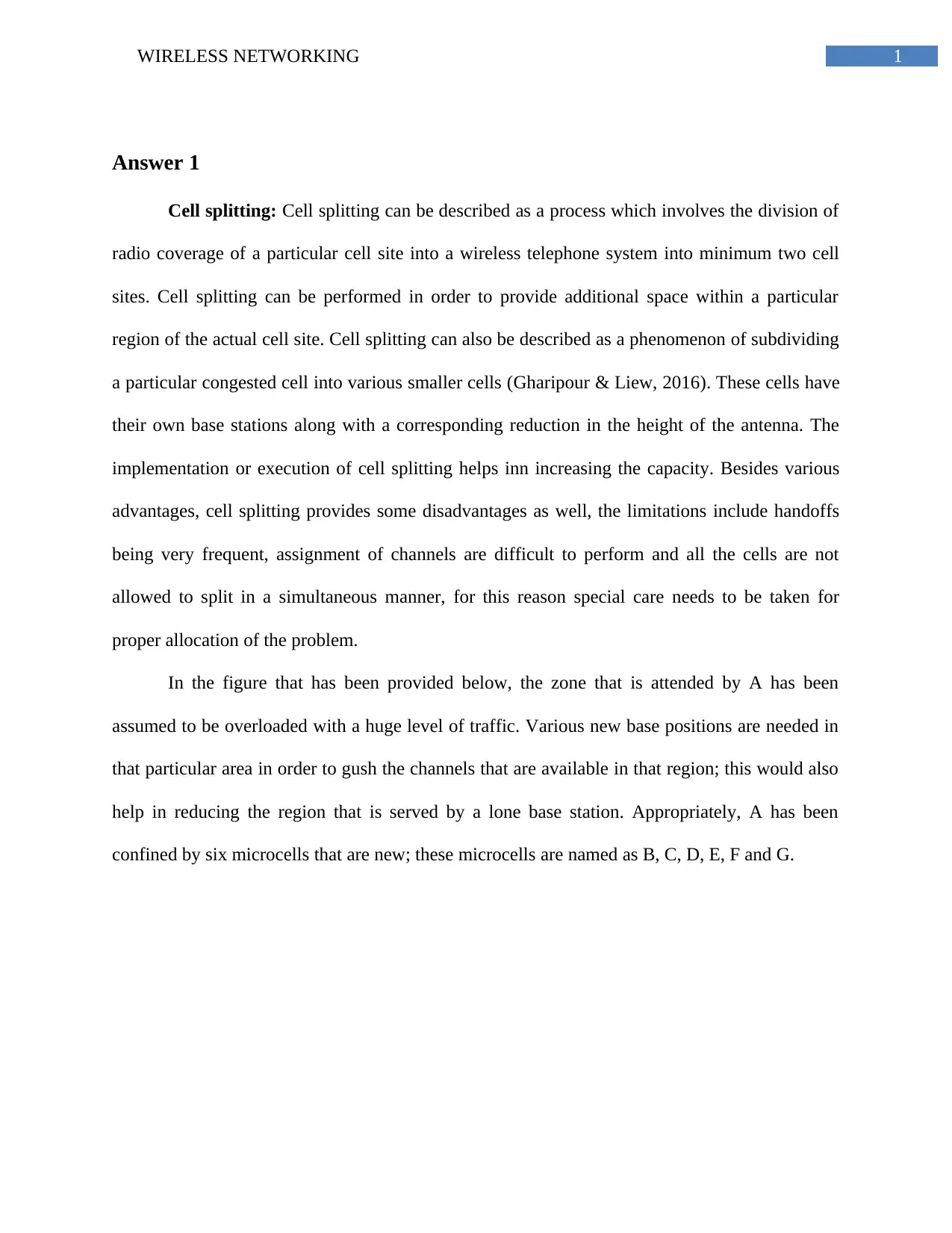
1WIRELESS NETWORKING
Answer 1
Cell splitting: Cell splitting can be described as a process which involves the division of
radio coverage of a particular cell site into a wireless telephone system into minimum two cell
sites. Cell splitting can be performed in order to provide additional space within a particular
region of the actual cell site. Cell splitting can also be described as a phenomenon of subdividing
a particular congested cell into various smaller cells (Gharipour & Liew, 2016). These cells have
their own base stations along with a corresponding reduction in the height of the antenna. The
implementation or execution of cell splitting helps inn increasing the capacity. Besides various
advantages, cell splitting provides some disadvantages as well, the limitations include handoffs
being very frequent, assignment of channels are difficult to perform and all the cells are not
allowed to split in a simultaneous manner, for this reason special care needs to be taken for
proper allocation of the problem.
In the figure that has been provided below, the zone that is attended by A has been
assumed to be overloaded with a huge level of traffic. Various new base positions are needed in
that particular area in order to gush the channels that are available in that region; this would also
help in reducing the region that is served by a lone base station. Appropriately, A has been
confined by six microcells that are new; these microcells are named as B, C, D, E, F and G.
Answer 1
Cell splitting: Cell splitting can be described as a process which involves the division of
radio coverage of a particular cell site into a wireless telephone system into minimum two cell
sites. Cell splitting can be performed in order to provide additional space within a particular
region of the actual cell site. Cell splitting can also be described as a phenomenon of subdividing
a particular congested cell into various smaller cells (Gharipour & Liew, 2016). These cells have
their own base stations along with a corresponding reduction in the height of the antenna. The
implementation or execution of cell splitting helps inn increasing the capacity. Besides various
advantages, cell splitting provides some disadvantages as well, the limitations include handoffs
being very frequent, assignment of channels are difficult to perform and all the cells are not
allowed to split in a simultaneous manner, for this reason special care needs to be taken for
proper allocation of the problem.
In the figure that has been provided below, the zone that is attended by A has been
assumed to be overloaded with a huge level of traffic. Various new base positions are needed in
that particular area in order to gush the channels that are available in that region; this would also
help in reducing the region that is served by a lone base station. Appropriately, A has been
confined by six microcells that are new; these microcells are named as B, C, D, E, F and G.
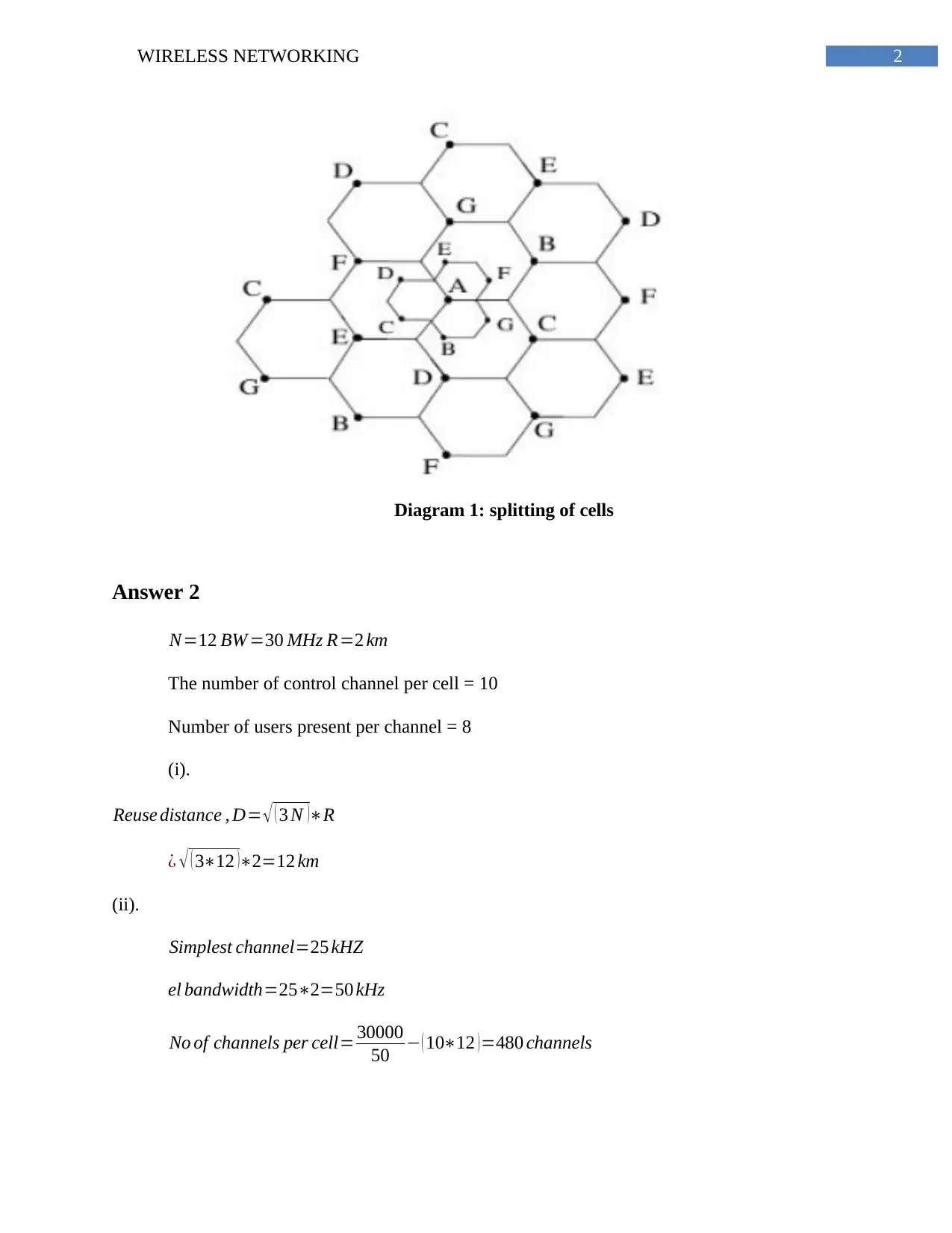
2WIRELESS NETWORKING
Diagram 1: splitting of cells
Answer 2
N=12 BW =30 MHz R=2 km
The number of control channel per cell = 10
Number of users present per channel = 8
(i).
Reuse distance , D= √ ( 3 N )∗R
¿ √ ( 3∗12 )∗2=12 km
(ii).
Simplest channel=25 kHZ
el bandwidth=25∗2=50 kHz
No of channels per cell= 30000
50 − ( 10∗12 )=480 channels
Diagram 1: splitting of cells
Answer 2
N=12 BW =30 MHz R=2 km
The number of control channel per cell = 10
Number of users present per channel = 8
(i).
Reuse distance , D= √ ( 3 N )∗R
¿ √ ( 3∗12 )∗2=12 km
(ii).
Simplest channel=25 kHZ
el bandwidth=25∗2=50 kHz
No of channels per cell= 30000
50 − ( 10∗12 )=480 channels
⊘ This is a preview!⊘
Do you want full access?
Subscribe today to unlock all pages.

Trusted by 1+ million students worldwide
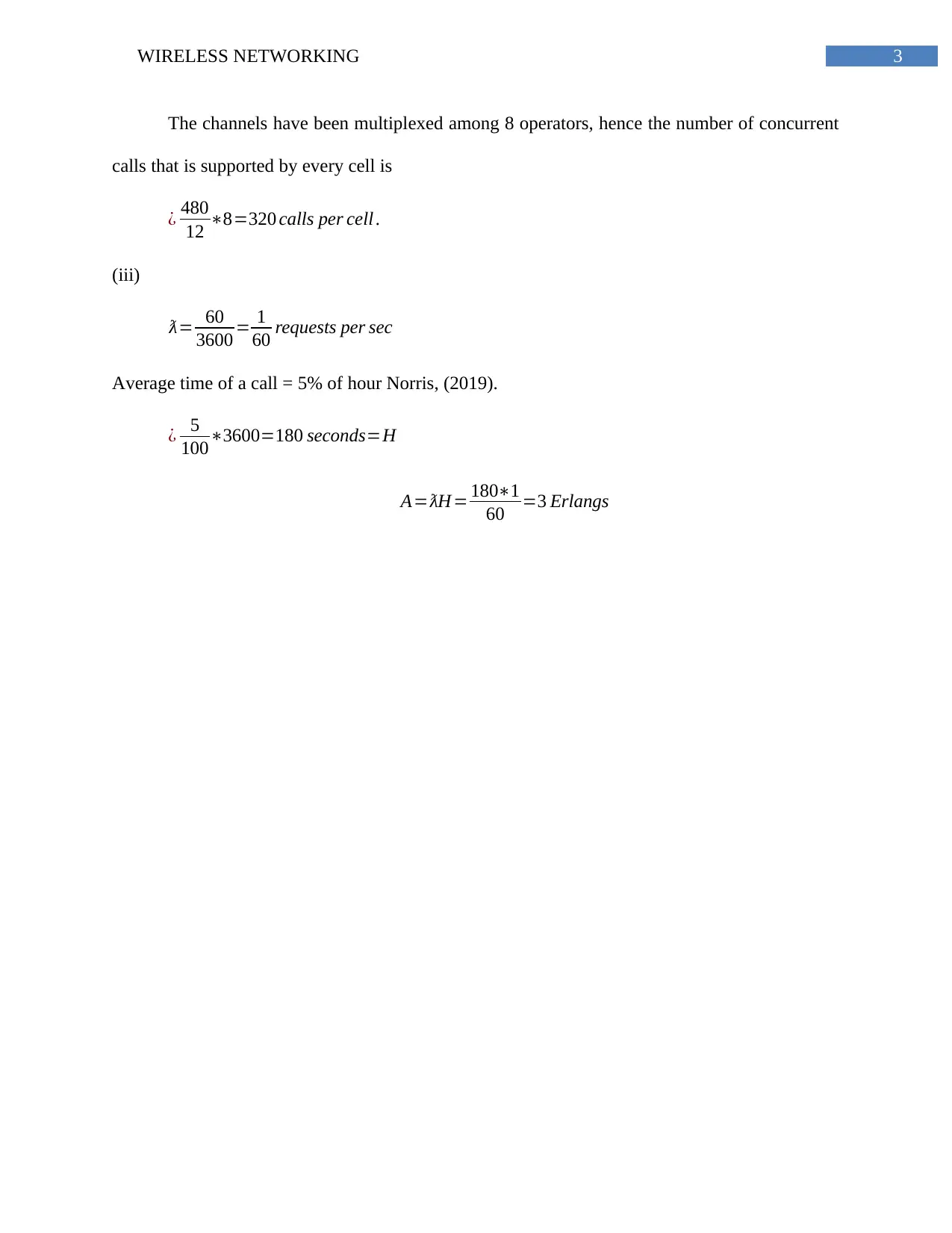
3WIRELESS NETWORKING
The channels have been multiplexed among 8 operators, hence the number of concurrent
calls that is supported by every cell is
¿ 480
12 ∗8=320 calls per cell .
(iii)
ƛ= 60
3600 = 1
60 requests per sec
Average time of a call = 5% of hour Norris, (2019).
¿ 5
100∗3600=180 seconds=H
A=ƛH = 180∗1
60 =3 Erlangs
The channels have been multiplexed among 8 operators, hence the number of concurrent
calls that is supported by every cell is
¿ 480
12 ∗8=320 calls per cell .
(iii)
ƛ= 60
3600 = 1
60 requests per sec
Average time of a call = 5% of hour Norris, (2019).
¿ 5
100∗3600=180 seconds=H
A=ƛH = 180∗1
60 =3 Erlangs
Paraphrase This Document
Need a fresh take? Get an instant paraphrase of this document with our AI Paraphraser
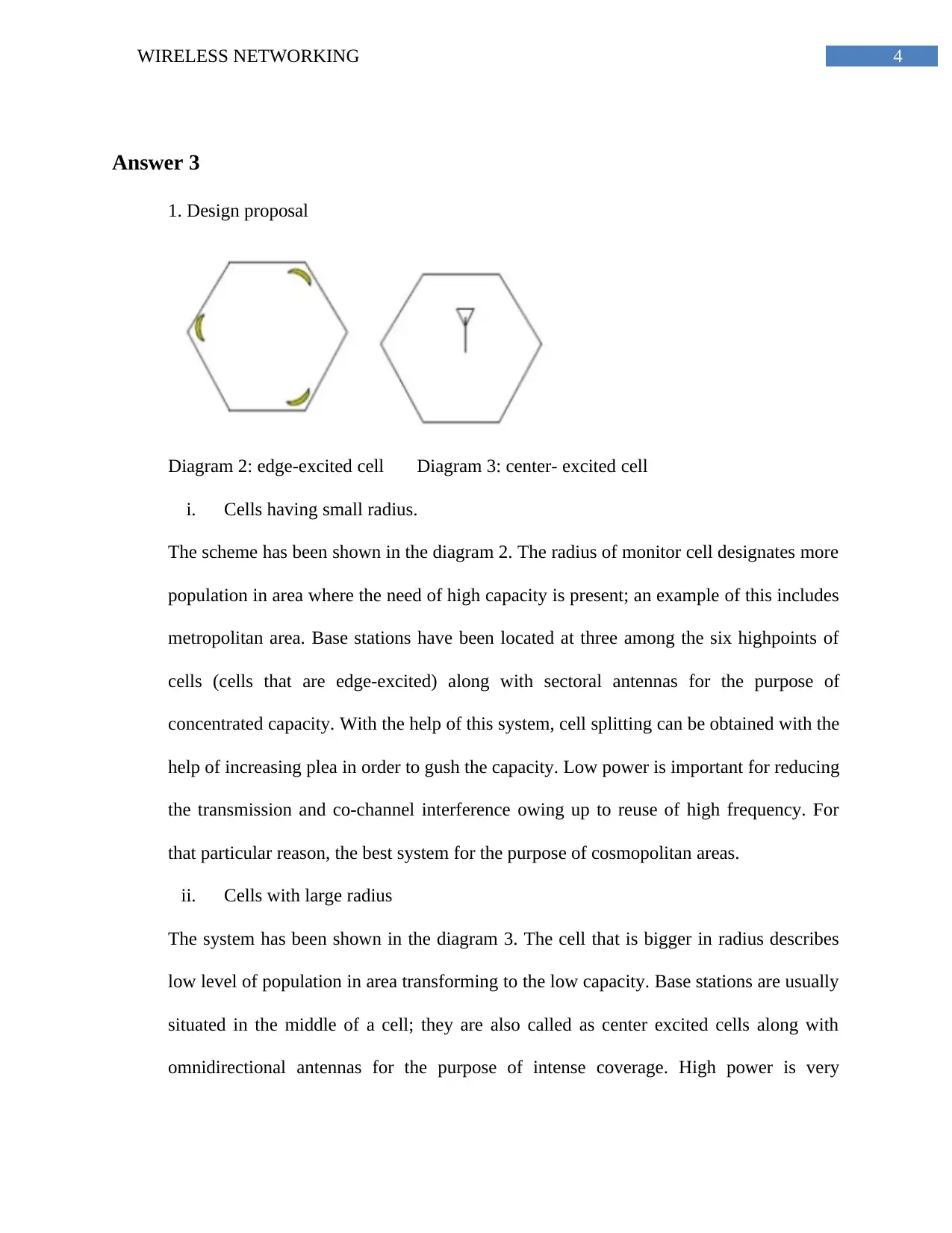
4WIRELESS NETWORKING
Answer 3
1. Design proposal
Diagram 2: edge-excited cell Diagram 3: center- excited cell
i. Cells having small radius.
The scheme has been shown in the diagram 2. The radius of monitor cell designates more
population in area where the need of high capacity is present; an example of this includes
metropolitan area. Base stations have been located at three among the six highpoints of
cells (cells that are edge-excited) along with sectoral antennas for the purpose of
concentrated capacity. With the help of this system, cell splitting can be obtained with the
help of increasing plea in order to gush the capacity. Low power is important for reducing
the transmission and co-channel interference owing up to reuse of high frequency. For
that particular reason, the best system for the purpose of cosmopolitan areas.
ii. Cells with large radius
The system has been shown in the diagram 3. The cell that is bigger in radius describes
low level of population in area transforming to the low capacity. Base stations are usually
situated in the middle of a cell; they are also called as center excited cells along with
omnidirectional antennas for the purpose of intense coverage. High power is very
Answer 3
1. Design proposal
Diagram 2: edge-excited cell Diagram 3: center- excited cell
i. Cells having small radius.
The scheme has been shown in the diagram 2. The radius of monitor cell designates more
population in area where the need of high capacity is present; an example of this includes
metropolitan area. Base stations have been located at three among the six highpoints of
cells (cells that are edge-excited) along with sectoral antennas for the purpose of
concentrated capacity. With the help of this system, cell splitting can be obtained with the
help of increasing plea in order to gush the capacity. Low power is important for reducing
the transmission and co-channel interference owing up to reuse of high frequency. For
that particular reason, the best system for the purpose of cosmopolitan areas.
ii. Cells with large radius
The system has been shown in the diagram 3. The cell that is bigger in radius describes
low level of population in area transforming to the low capacity. Base stations are usually
situated in the middle of a cell; they are also called as center excited cells along with
omnidirectional antennas for the purpose of intense coverage. High power is very
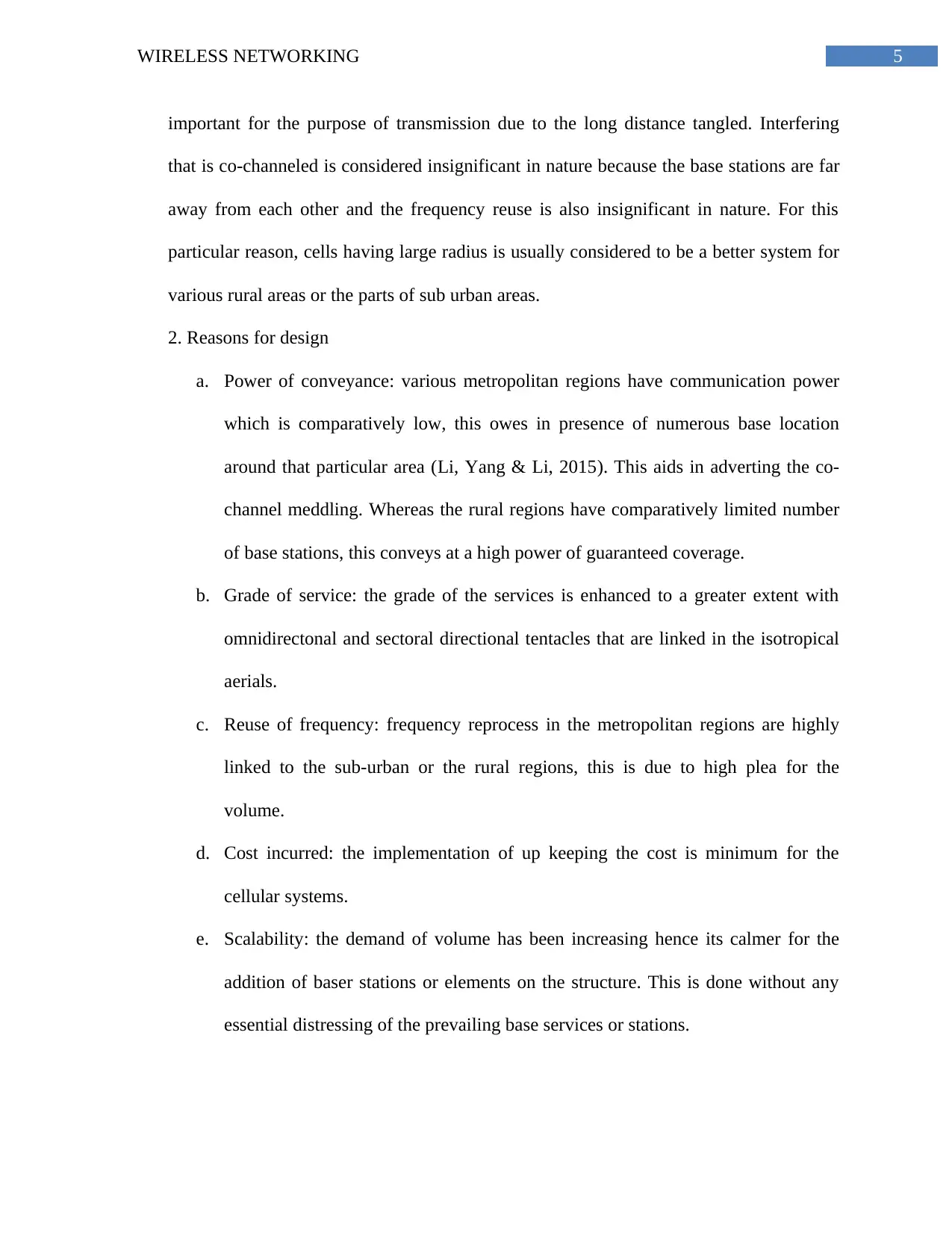
5WIRELESS NETWORKING
important for the purpose of transmission due to the long distance tangled. Interfering
that is co-channeled is considered insignificant in nature because the base stations are far
away from each other and the frequency reuse is also insignificant in nature. For this
particular reason, cells having large radius is usually considered to be a better system for
various rural areas or the parts of sub urban areas.
2. Reasons for design
a. Power of conveyance: various metropolitan regions have communication power
which is comparatively low, this owes in presence of numerous base location
around that particular area (Li, Yang & Li, 2015). This aids in adverting the co-
channel meddling. Whereas the rural regions have comparatively limited number
of base stations, this conveys at a high power of guaranteed coverage.
b. Grade of service: the grade of the services is enhanced to a greater extent with
omnidirectonal and sectoral directional tentacles that are linked in the isotropical
aerials.
c. Reuse of frequency: frequency reprocess in the metropolitan regions are highly
linked to the sub-urban or the rural regions, this is due to high plea for the
volume.
d. Cost incurred: the implementation of up keeping the cost is minimum for the
cellular systems.
e. Scalability: the demand of volume has been increasing hence its calmer for the
addition of baser stations or elements on the structure. This is done without any
essential distressing of the prevailing base services or stations.
important for the purpose of transmission due to the long distance tangled. Interfering
that is co-channeled is considered insignificant in nature because the base stations are far
away from each other and the frequency reuse is also insignificant in nature. For this
particular reason, cells having large radius is usually considered to be a better system for
various rural areas or the parts of sub urban areas.
2. Reasons for design
a. Power of conveyance: various metropolitan regions have communication power
which is comparatively low, this owes in presence of numerous base location
around that particular area (Li, Yang & Li, 2015). This aids in adverting the co-
channel meddling. Whereas the rural regions have comparatively limited number
of base stations, this conveys at a high power of guaranteed coverage.
b. Grade of service: the grade of the services is enhanced to a greater extent with
omnidirectonal and sectoral directional tentacles that are linked in the isotropical
aerials.
c. Reuse of frequency: frequency reprocess in the metropolitan regions are highly
linked to the sub-urban or the rural regions, this is due to high plea for the
volume.
d. Cost incurred: the implementation of up keeping the cost is minimum for the
cellular systems.
e. Scalability: the demand of volume has been increasing hence its calmer for the
addition of baser stations or elements on the structure. This is done without any
essential distressing of the prevailing base services or stations.
⊘ This is a preview!⊘
Do you want full access?
Subscribe today to unlock all pages.

Trusted by 1+ million students worldwide
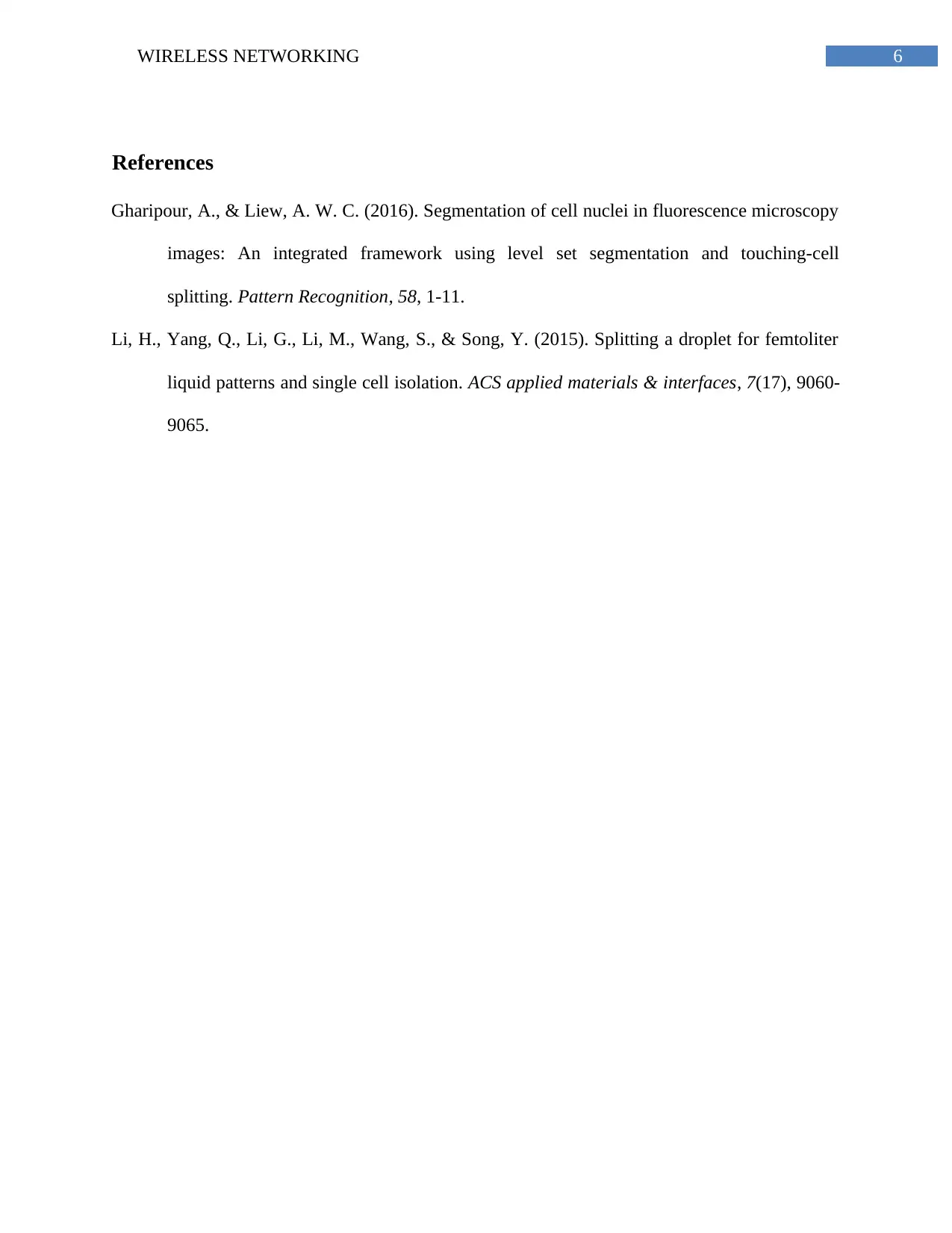
6WIRELESS NETWORKING
References
Gharipour, A., & Liew, A. W. C. (2016). Segmentation of cell nuclei in fluorescence microscopy
images: An integrated framework using level set segmentation and touching-cell
splitting. Pattern Recognition, 58, 1-11.
Li, H., Yang, Q., Li, G., Li, M., Wang, S., & Song, Y. (2015). Splitting a droplet for femtoliter
liquid patterns and single cell isolation. ACS applied materials & interfaces, 7(17), 9060-
9065.
References
Gharipour, A., & Liew, A. W. C. (2016). Segmentation of cell nuclei in fluorescence microscopy
images: An integrated framework using level set segmentation and touching-cell
splitting. Pattern Recognition, 58, 1-11.
Li, H., Yang, Q., Li, G., Li, M., Wang, S., & Song, Y. (2015). Splitting a droplet for femtoliter
liquid patterns and single cell isolation. ACS applied materials & interfaces, 7(17), 9060-
9065.
1 out of 7
Related Documents
Your All-in-One AI-Powered Toolkit for Academic Success.
+13062052269
info@desklib.com
Available 24*7 on WhatsApp / Email
![[object Object]](/_next/static/media/star-bottom.7253800d.svg)
Unlock your academic potential
Copyright © 2020–2025 A2Z Services. All Rights Reserved. Developed and managed by ZUCOL.





